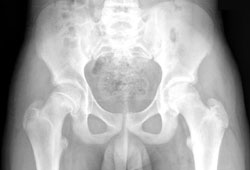Summary
Definition
History and exam
Key diagnostic factors
- weight (>90th percentile)
- gait with affected leg externally rotated
Other diagnostic factors
- groin or knee pain
- bilateral hip pain
- Trendelenburg gait
- restricted range of motion
- weight (<50th percentile)
- symptoms of hypothyroidism or panhypopituitarism
- renal failure
- recent trauma
Risk factors
- puberty
- African-American ancestry
- Hispanic ancestry
- northeastern or western US
- obesity
- male sex
- endocrine disorders
- vitamin D deficiency
- prior radiation therapy
Diagnostic investigations
1st investigations to order
- bilateral anteroposterior radiographs
- frog-leg lateral radiographs
Investigations to consider
- metabolic panel
- serum thyroid function tests
- serum growth hormone
Treatment algorithm
unstable SCFE
stable SCFE
late deformity
Contributors
Authors
Jonathan Wright, MBBS, FRCS (Tr & Orth)
Consultant Orthopaedic Surgeon
Catterall Unit, Department of Paediatric Orthopaedics
Royal National Orthopaedic Hospital
Stanmore
London
UK
Disclosures
JW is an author of a reference cited in this topic.
Neil Segaren, MBBS, FRCS
Consultant Orthopaedic Surgeon
Catterall Unit, Department of Paediatric Orthopaedics
Royal National Orthopaedic Hospital
Stanmore
London
UK
Disclosures
NS declares that he has no competing interests.
Acknowledgements
Mr Jonathan Wright and Mr Neil Segaren would like to gratefully acknowledge Dr Randall T. Loder, Dr John M. Flynn, Dr Purushottam A. Gholve, Dr Danielle B. Cameron, and Dr Patrick O'Toole, previous contributors to this topic.
Disclosures
RTL receives book royalties and performs legal consultancy. RTL is an author of a number of references cited in this topic. JMF, PAG, DBC, and PO declare that they have no competing interests.
Peer reviewers
James McCarthy, MD, FAAOS, FAAP
Associate Professor
Department of Orthopedics and Rehabilitation
University of Wisconsin School of Medicine and Public Health
Madison
WI
Disclosures
JM declares that he has no competing interests.
D. Philip Thomas, MB, BS, FRCS
Consultant Orthopaedic Surgeon and Honorary Lecturer
University Hospital of Wales
Cardiff
UK
Disclosures
DPT declares that he has no competing interests.
Nicholas M. Clarke, ChM, FRCS
Professor
Consultant Orthopaedic Surgeon
Developmental Origins of Health and Disease (DOHaD)
School of Medicine
University of Southampton
Southampton
UK
Disclosures
NMC has received honoraria for visiting professorships in North America and also for lectures in respect of congenital hip dysplasia. He is also a founding member of the International Hip Dysplasia Institute, which has received charitable funding.
Peer reviewer acknowledgements
BMJ Best Practice topics are updated on a rolling basis in line with developments in evidence and guidance. The peer reviewers listed here have reviewed the content at least once during the history of the topic.
Disclosures
Peer reviewer affiliations and disclosures pertain to the time of the review.
References
Key articles
Perry DC, Arch B, Appelbe D, et al. The British Orthopaedic Surgery Surveillance study: slipped capital femoral epiphysis: the epidemiology and two-year outcomes from a prospective cohort in Great Britain. Bone Joint J. 2022 Apr;104-B(4):519-28.Full text Abstract
Aprato A, Conti A, Bertolo F, et al. Slipped capital femoral epiphysis: current management strategies. Orthop Res Rev. 2019;11:47-54.Full text Abstract
Sucato DJ. Approach to the hip for SCFE: the North American perspective. J Pediatr Orthop. 2018 Jul;38 Suppl 1:S5-12.Full text Abstract
Wright J, Ramachandran M. Slipped capital femoral epiphysis: the European perspective. J Pediatr Orthop. 2018 Jul;38 Suppl 1:S1-4.Full text Abstract
Reference articles
A full list of sources referenced in this topic is available to users with access to all of BMJ Best Practice.

Differentials
- Hip fractures
- Avascular necrosis
- Legg-Calve-Perthes disease
More DifferentialsGuidelines
- Open reduction of slipped capital femoral epiphysis
More GuidelinesLog in or subscribe to access all of BMJ Best Practice
Use of this content is subject to our disclaimer
